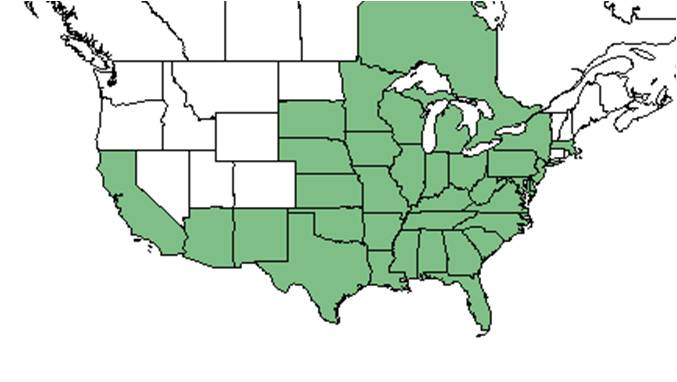Eclipta prostrata
| Eclipta prostrata | |
|---|---|

| |
| Scientific classification | |
| Kingdom: | Plantae |
| Division: | Magnoliophyta - Flowering plants |
| Class: | Magnoliopsida - Dicotyledons |
| Order: | Asterales |
| Family: | Asteraceae ⁄ Compositae |
| Genus: | Eclipta |
| Species: | E. prostrata |
| Binomial name | |
| Eclipta prostrata (L.) L. | |

| |
| Natural range of Eclipta prostrata from USDA NRCS Plants Database. | |
Common name: false daisy
Contents
Taxonomic notes
Eclipta comes from the greek word "ekleipta" (deficient) which refers to the absence of the pappus on the achene (Fernald 1950).
Description
A description of Eclipta prostrata is provided in The Flora of North America.
E. prostrata is an annual and can be a short-lived perennial in warmer climates. The reddish-purple stems are covered with short, stiff hairs and can grow prostrate or decumbent and branch occasionally. The leaves are subsessile, elliptic-lanceolate and arranged opposite, with a few blunt teeth along the margin [1]. 1-3 composite flower heads on short pedicels emerge from the axils of the leaves. The ray florets are white, narrow, and short while the disk florets are cream with four small spreading lobes with pale yellow or light brown anthers emerging from them. The bracts form the base of the flowerhead and are green and triangular.
It is a noxious weed in many agricultural crops such as soybean, cotton, rice, sugarcane, peanut, and corn (Chauhan and Johnson 2008).
Distribution
It is native to the Southeastern United States, but can also be found in Asia and South America (Holm et al. 1997).
Ecology
Habitat
Eclipta prostata can be found in shallow water in shaded Acer-Nyssa-Taxodium swamps; cypress depression swamps; marsh edges; lake shores; river banks; brackish marshes; seepage areas in calcareous talus; moist sandy-peaty clearings of Baccharis flats; sandy loam of coastal hammocks; pine flatwoods; and river floodplains (FSU Herbarium).It is a noxious weed in many agricultural crops such as peanuts, soybean, cotton, rice, sugarcane and corn (Chauhan and Johnson 2008). E. prostrata favors moist conditions and has been observed in gardens, holding ponds, and drainage ditches (FSU Herbarium). Substrate types include sandy peat, loamy sand and sandy loam soils (FSU Herbarium). Associated species include Typha, Erechtites, Ludwigia, Juncus, Mitreola, Fuirena, and Rhynchospora (FSU Herbarium).
Phenology
It has a composite flower head that consists of 8 to 16 green triangular bracts; narrow, white ray florets; and cream short disk florets with yellow or light brown anthers protruding[1]. Flowers June through November (FSU Herbarium).
Achenes are oblong, truncate at the top and tapering to a well rounded tip at the bottom and develop in a flowerhead after the petals fall off[1].
Seed dispersal
Seed bank and germination
E. prostrata is a noxious weed in agronomic crops and container grown plants (Gleen et al. 2006). Seeds favor saturated conditions foer germination and are strongly photoblastic, no seeds will germinate without light (Chauhan and Johnson 2008). Germination can occur over a range of temperatures from 10 to 35 C; however, germination has observed to have the highest rate (83%) at a constant temperature of 35C. In peanut fields, it has been observe to germinate in the summer; and early rainfall, irrigation or wetter seasons favor germination in peanut fields (Altom and Murray 1996).
Fire ecology
Pollination
The following Hymenoptera families and species were observed visiting flowers of Eclipta prostrata at Archbold Biological Station (Deyrup 2015):
Colletidae: Hylaeus confluens
Halictidae: Halictus poeyi, Lasioglossum placidensis, L. puteulanum, L. tamiamensis
Sphecidae: Cerceris tolteca, Ectemnius rufipes ais
Vespidae: Parancistrocerus perennis anacardivora, P. salcularis rufulus, Stenodynerus fundatiformis
Use by animals
Diseases and parasites
Conservation and Management
Cultivation and restoration
Photo Gallery
References and notes
Deyrup, M.A. and N.D. 2015. Database of observations of Hymenoptera visitations to flowers of plants on Archbold Biological Station, Florida, USA.
Florida State University Robert K. Godfrey Herbarium database. URL: http://herbarium.bio.fsu.edu. Last accessed: October 2015. Collectors: Loran C. Anderson, Linnea Angermuller, Sydney T. Bacchus, Kurt E. Blum, D. Burch, Andre F. Clewell, A.H. Curtiss, J.A. Duke, J. Dwyer, R.K. Godfrey, Ann F. Johnson, G.R. Knight, R. Kral, Robert L. Lazor, S.W. Leonard, H. Loftin, J.R. Martinez, Herbert Monoson, C. Nelson, R.A. Norris, Paul L. Redfearn Jr., Grady W. Reinert, Manuel Rimachi Y., Deborah R. Shelley, Sidney Thompson, Edwin L. Tyson, D.B. Ward. States and Counties: Florida: Bay, Brevard, Calhoun, Citrus, Dixie, Flagler, Franklin, Hernando, Jackson, Jefferson, Lake, Lee, Leon, Liberty, Madison, Martin, Sarasota, Seminole, Wakulla, Washington. Georgia: Grady. Country: Columbia, Honduras, Panama, Peru. Compiled by Tall Timbers Research Station and Land Conservancy.
- ↑ 1.0 1.1 1.2 [Encyclopedia of Life] Accessed: December 9, 2015